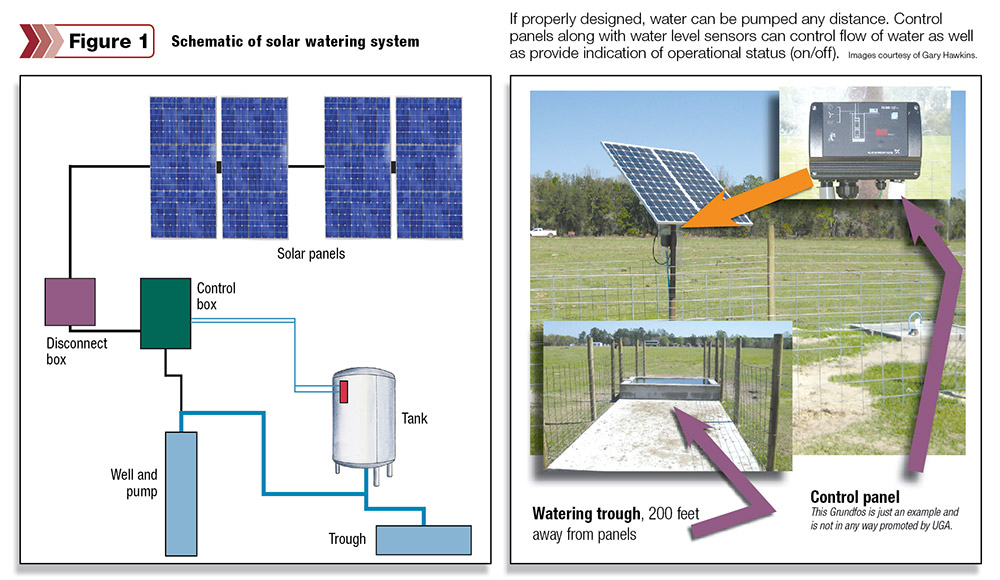If there is no power line close to the needed area, you may consider using solar power.
In recent years, as an alternative energy specialist with the University of Georgia Crop and Soil Science Department, I have worked with farmers across the Southeast to install and demonstrate solar-powered pumping systems to provide water for livestock.
Installations have occurred in the central, southeast and northeast portions of Georgia as well as South Carolina. Other than these demonstration sites, many farmers have worked with solar companies to install solar-powered watering systems.
A solar-powered watering system is designed just like any other watering system. Differences include the power source and maybe the volume of water pumped.
Current solar-powered pumps (typically DC pumps) can pump between 0.7 to 230 gallons per minute based on many factors such as pumping height and voltage used.
Differences are related to the manufacture and how they are constructed.
Solar-powered pumping systems can be purchased from many different sources including dealers, catalogues, Internet or farm and outdoor stores.
A caution should be noted that when buying a solar-powered watering system from a source other than a dealer, the farmer should make sure they have enough power to pump the water they need.
Needed information consists of the number of animals needing water, what volume an animal needs daily (I use 20 gallons per day per animal), what is the pumping pressure and daily sun availability.
With this information, a solar system can be designed to provide enough water for the herd. If the cattleman has questions on using the gathered information, please contact your local county extension agent or NRCS for assistance.
Some NRCS regions also have solar-powered systems written into their cost-share list, but check with the local office for more information on this.
General concerns related to the use of solar-powered systems are the ability to get enough water and the cost. If properly designed, the volume of water produced will provide ample water for your animals.
There is no way to estimate the cost of a solar-powered water system in this article, but a basic system consisting of a pump, two solar panels (24-volt, 185 watts), controllers, wiring and pipe will cost on the order of $3,000 to $6,000 based on the type of pump purchased, the panels and where you buy the system. The price for any system could be lower or higher based on many factors listed in the system design.
The distance to a power line should also be considered or the cost to run power to the pumping location. Batteries can be used to provide power during dark times, but I would also offer some caution when considering batteries.
If the system is designed properly and a large enough storage vessel is included to provide water for two days, the batteries are most likely not needed. Batteries also need to be maintained, which also needs to be considered.
Even though solar-powered pumping systems can potentially be designed to handle the number of cattle needing water, if a power line is close to the pumping location, the system may not pay for itself.
Before a cattleman buys a system, I would just remind them that this is a good way to get water to animals but should be considered based on many factors.
Cattle and other livestock need water to survive but sometimes, as cattlemen use best management practices of keeping animals out of water bodies or move them from paddock to paddock, the needed water may be lacking. However, the sun can be a means of getting water for those animals in areas isolated from a water source.
Solar-powered watering systems are designed and work like any water pumping system with the exception of the power source.
Even though we can use solar-powered systems to provide water for cattle, some cautions should be considered when looking at a solar system.
However, if the location of needed water is a distance from a power line and there are no other water sources, a solar-powered system potentially can be designed.
So before you give up on moving animals around the paddocks due to lack of water, first look up to see if the sun is shining and if that could be a means of getting water to your cattle. ![]()
Gary Hawkins is with the department of Crop and Soil Science at the University of Georgia.
References omitted due to space but are available upon request. Click here to email an editor.
PHOTO
One way to get water to animals is to use solar-powered pumping systems. Photo by Gary Hawkins.








